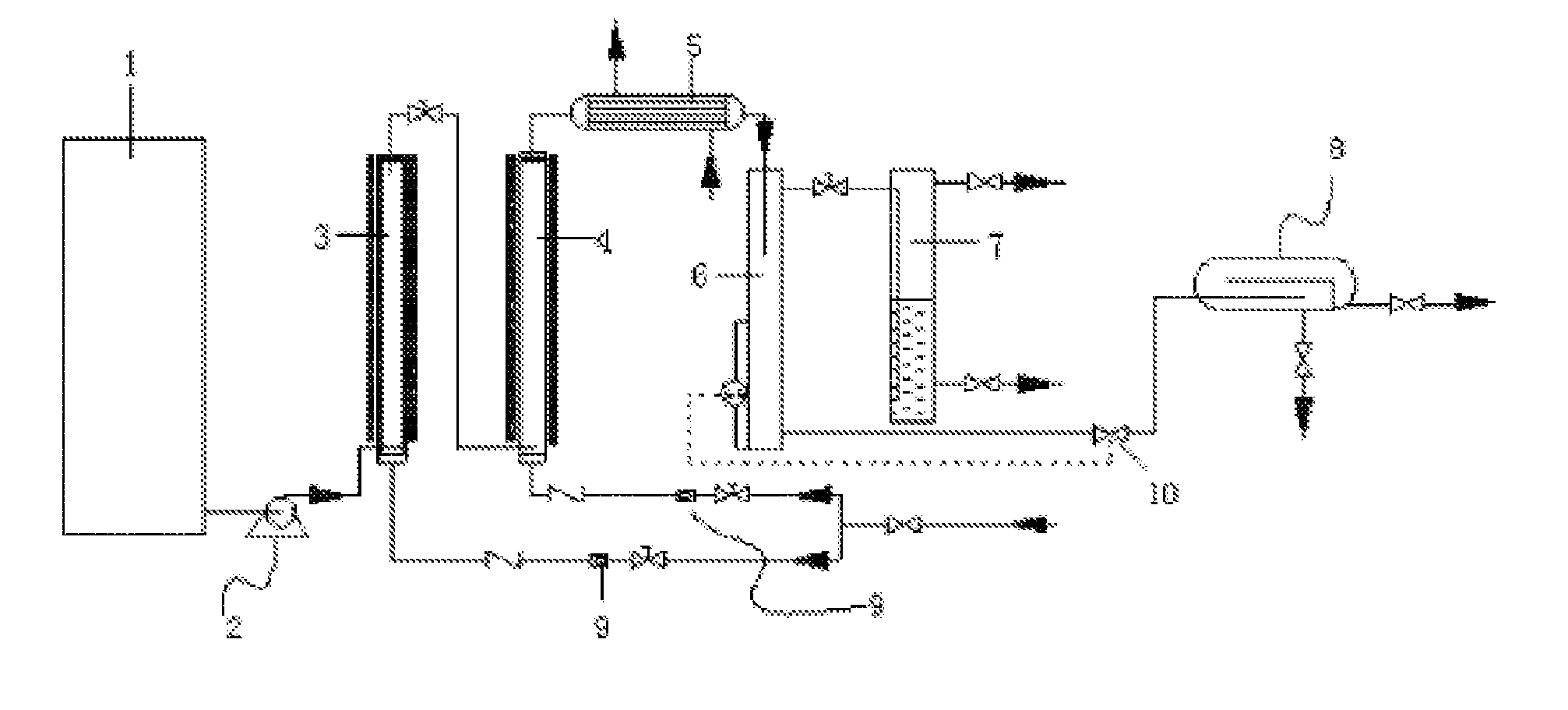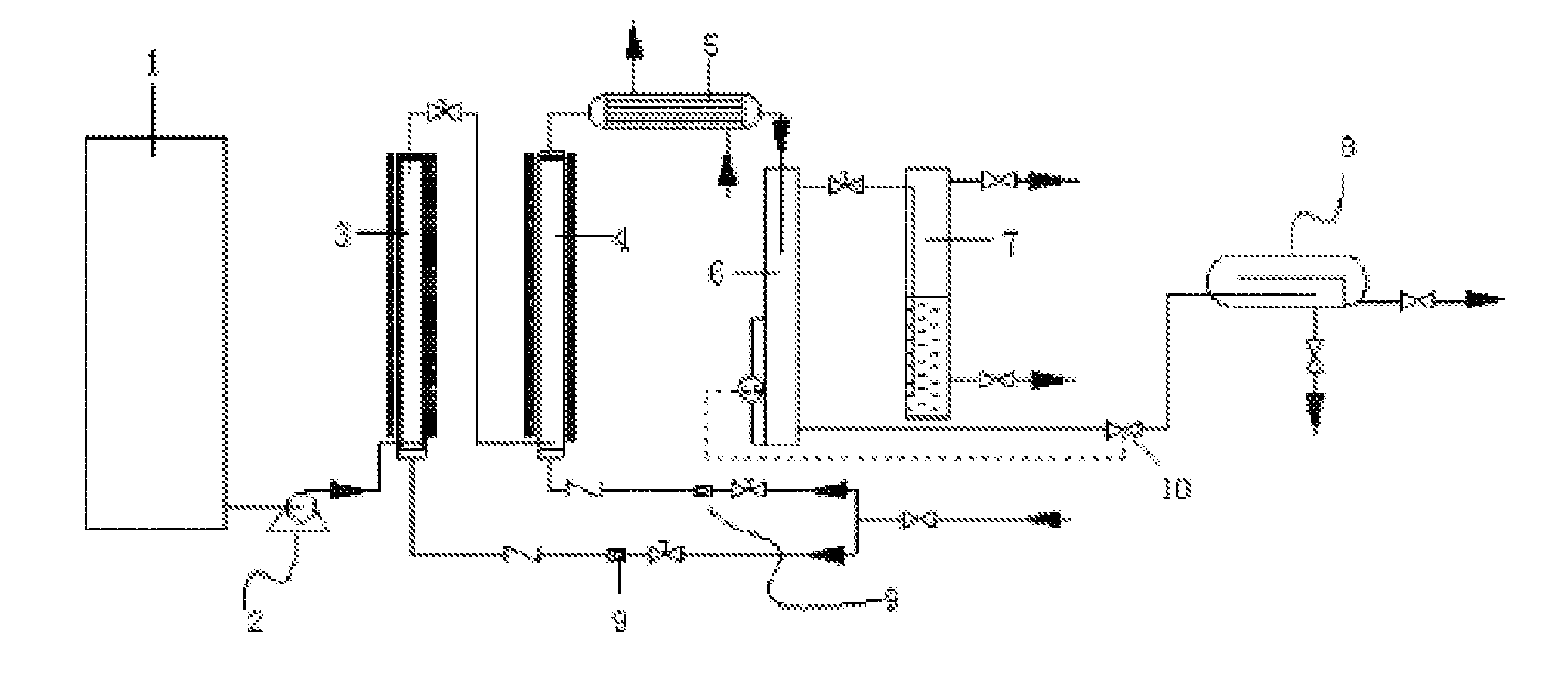Process for hydrolysed reforming of liquous cellulose biomass to produce bio-gasoline
a technology of hydrolysis and biomass, which is applied in the field of biomass energy and chemical engineering, can solve the problems of short service life and tendency of catalysts to accumulate carbon, and achieve the effect of reducing equipment corrosion and low acidity
- Summary
- Abstract
- Description
- Claims
- Application Information
AI Technical Summary
Benefits of technology
Problems solved by technology
Method used
Image
Examples
example 1
[0031]A method for preparing the hydrolyzed raw material solution comprises the following steps:
[0032](1) Add 20 g sawdust in 500 ml high temperature liquid water at 200° C. and 5.0 MPa for 90 min of hydrolysis; when the hydrolysis is completed, filter, and the filtrate (i.e. high temperature liquid water hydrolysis solution) directly enters the hydrolysis solution tank 1,
[0033](2) The hydrolysis residue after the filtration continues to be hydrolyzed in 500 ml extremely low maleic acid solution with concentration of 0.1 wt. % for 30 min (hydrolysis conditions: 220° C. and 5.0 MPa), and then filter; the filtrate is the extremely low maleic acid hydrolysis solution;
[0034](3) Discard lignose that has not been hydrolyzed, and the extremely low maleic acid hydrolysis solution enters the hydrolysis solution tank 1 to be mixed with the high temperature liquid water hydrolysis solution to form the hydrolyzed raw material solution.
example 2
[0035]A method for preparing the hydrolyzed raw material solution, the high temperature liquid water has a temperature of 200° C. and pressure of 4.0 MPa, and the hydrolysis time is 65 min; the maleic acid solution has a concentration of 0.06 wt. %, 190° C. and 3.0 MPa, and the hydrolysis time is 15 min. Other operation modes and reaction conditions are the same as those in Example 1.
example 3
[0036]A method for preparing the hydrolyzed raw material solution, the high temperature liquid water has a temperature of 180° C. and pressure of 2.0 MPa, and the hydrolysis time is 40 min; the maleic acid solution has a concentration of 0.01 wt. %, 160° C. and 2.0 MPa, and the hydrolysis time is 10 min. Other operation modes and reaction conditions are the same as those in Example 1.
[0037]Measure the hydrolysis results in Examples 1-3 with the results listed in Table 1. It can be seen from Table 1 that: Example 2 has relatively ideal results. Its hydrolysis conditions are relatively mild. Although its total conversion rate is not as good as that in Example 1, it has the highest monosaccharide concentration in the hydrolysis solution, which is beneficial for subsequent aqueous phase catalytic reforming reaction.
[0038]
TABLE 1Hydrolysis Results of All ExamplesTotal conversion rateMonosaccharide concentration(wt. %)(g / L)Example 160.68.19Example 253.89.69Example 339.77.11
[0039]In Exampl...
PUM
| Property | Measurement | Unit |
|---|---|---|
| temperature | aaaaa | aaaaa |
| temperature | aaaaa | aaaaa |
| temperature | aaaaa | aaaaa |
Abstract
Description
Claims
Application Information
 Login to View More
Login to View More - R&D
- Intellectual Property
- Life Sciences
- Materials
- Tech Scout
- Unparalleled Data Quality
- Higher Quality Content
- 60% Fewer Hallucinations
Browse by: Latest US Patents, China's latest patents, Technical Efficacy Thesaurus, Application Domain, Technology Topic, Popular Technical Reports.
© 2025 PatSnap. All rights reserved.Legal|Privacy policy|Modern Slavery Act Transparency Statement|Sitemap|About US| Contact US: help@patsnap.com


